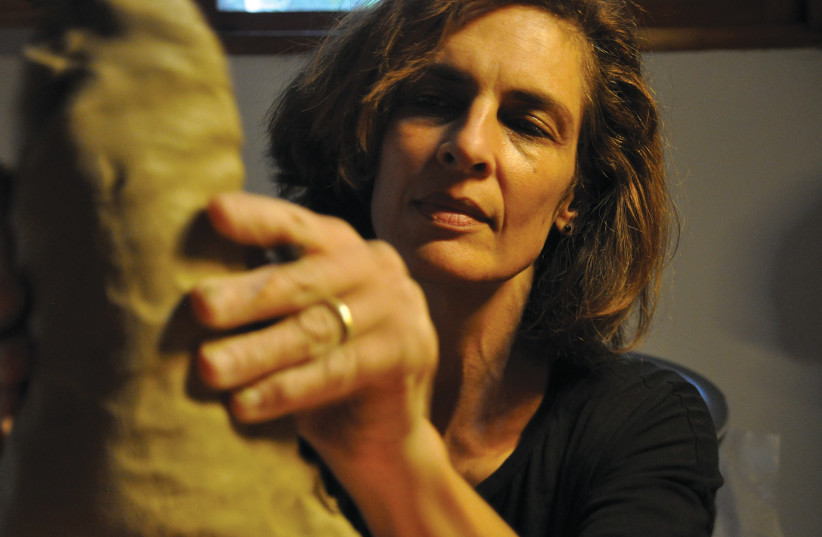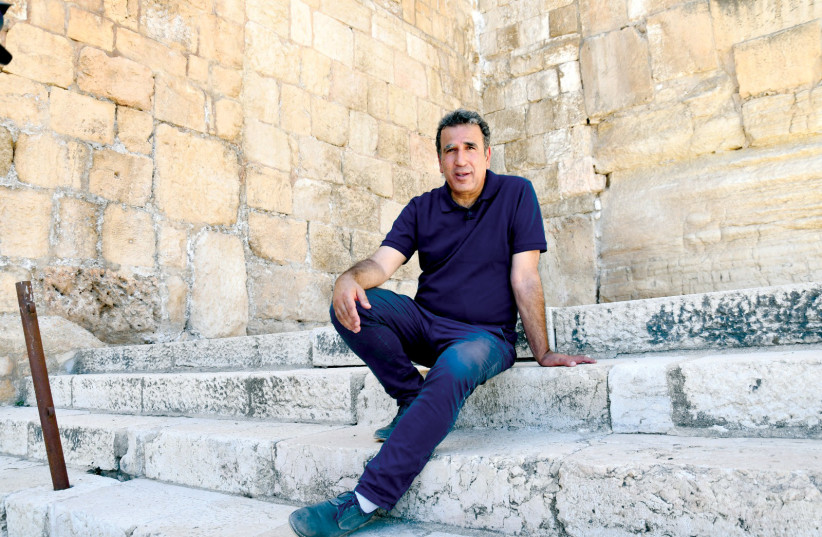According to Dr. Yuval Baruch, we are material. That much should be pretty obvious but, when the remark comes from a seasoned archaeologist with more than two decades of delving into strata that physically and historically underpin the Old City of Jerusalem, one may assume that is a learned observation with some collateral to it.
Notwithstanding his day job of exploring the past, Baruch, who works with the Antiquities Authority, is keen to convey the idea that the past was once the present. With that mindset, collaborating with Nicole Kornberg-Jacobovici looks like an ideal fit.
Canadian-born, Ra’anana-resident artist Kornberg-Jacobovici has just put on a groundbreaking exhibition at a unique location. For the past three days the “Arteology” display, which closes today, has been open to the public at an active underground archaeological site adjacent to the bedrock of the Western Wall. The fact that the art offering is set in the middle of an ongoing, unfolding archaeological context alone adds a fascinating dimension to the project.
The exhibition’s full title, “Arteology: The Power of the Ancients in Contemporray Forms,“ spells out the intent and the artistic line of attack. Abutting the monumental 2,000-year-old foundation stones of the Western Wall, and within the narrow and circular areas of the ancient water system some five meters below ground, the ceramics spread comprises 27 pieces that feed off Kornberg-Jacobovici’s studies of Bronze Age Egyptian, Mycenaean, Etruscan and Israelite pottery, as well as her hands-on creative expertise.
All of the aforesaid civilizations were located in and around this Mediterranean neck of the woods. The idea is to take the show on the road and unfurl some of the reimagined regional sensibilities to all kinds of cultures and societies across the globe.

“I want this to be accessible to everyone,” Kornberg-Jacobovici says. “The idea is, after Sukkot, to take this to galleries in Israel and to places like Greece and Japan. These are countries that treasure ceramics and history and archaeology and are connected to appreciation of aesthetics.”
“The idea is, after Sukkot, to take this to galleries in Israel and to places like Greece and Japan. These are countries that treasure ceramics and history and archaeology and are connected to appreciation of aesthetics.”
Nicole Kornberg-Jacobovici
Kornberg-Jacobovici, who certainly appreciates visual beauty, has assembled a highly varied and enticing collection of pottery works that run the gamut of styles and designs. These range from primitive-looking items that might just as well have come straight out of an archaeological dig, with clumps of earth or sand still clinging to their roughly combed exterior, to creations that give the impression of a painstaking, labor-intensive process.
There are generously glazed stoneware plates with carved picturesque images and sequential scenes, and burnished raku clay exhibits that resonate the Japanese ceramic school of thought, in which the artist has etched compelling figurative statements.
A stoneware imprinted cylinder seal, called Joseph’s Dreams, is reminiscent of a temple frieze or fresco storyboard rollout with animal shapes, a couple of ancient Egyptian-style profiles and all manner of celestial and floral elements that suggest rich narratives.
EYE-CATCHING aesthetics jump out at you every way you turn in the exhibition.
Vase with Cherubs is a carved, glazed earthenware celebration of form, style and motifs topped by a couple of exotic-looking winged creatures. And the comically named Fishify double-handled pitcher is a whimsically crafted piece that engages the observer, while Etruscan Vessel with its alluring black clay and stamped geometric squiggles also makes for entertaining viewing.
Kornberg-Jacobovici says she wants to reach out to the world, in both directions. By taking her locally inspired works abroad, she hopes to bring a little of Jerusalem, and the special “Arteology” curtain raiser location, to foreign pastures. The idea is to try to replicate the subterranean setting and to envelop the pottery works in something akin to the cavernous Old City ambiance wherever they are displayed.
“We have a photographer who is taking pictures of the setup [in Jerusalem]. The idea is to recreate the space the works are in, with big pictures. There will be large blown-up pictures with the texture of the walls and the space to recreate the feeling of the space.”
Ask any artist in any discipline about their complementary past-present-future ethos, and they will tell you that you have to understand your roots in order to forge your way ahead. Kornberg-Jacobovici undoubtedly gets that. “I am very interested in the aesthetics of the past,” she says. “It is part of my history. It’s where I come from.”
She is looking to promulgate that work as far and as wide as she possibly can. She says there is great interest in the exhibition in Japan, and there are talks regarding a slot for it over there. She is also, naturally, keen to secure a berth for “Arteology” in her former country of residence.

“I am from Toronto. There is a very well-known art ceramic museum there called the Gardiner. I am thinking of offering the exhibition to them.” Considering the illustrious Canadian artwork repository’s mission statement “We interpret historical ceramics to emphasize their relevance today” and “We believe in making, looking, and thinking through clay,” that seems a pertinent presentation choice.
BARUCH, WHO served as the professional consultant on the “Arteology” venture, is well on board the dissemination train. However, when it comes to making the unearthed fruits of their craft available to the man or woman on the street, he says there are divided opinions among his co-professionals.
“Not every archaeologist agrees with the approach that archaeology needs to break through the scientific-academic frameworks. I think that, as archaeology also engages in heritage and also offers access to [archaeological] sites, making archaeology accessible is definitely an integral part of all of this.”
Baruch believes you cannot talk about Jerusalem without addressing its long, rich colorful and checkered past. And that necessarily means informing people, regardless of their origins, about the local archaeological and historical narrative.
One of the basic differences between the work of the archaeologist and the historian is that the former have to get their hands dirty and literally dig into the tangible substrata of our current everyday life. Historians, on the other hand, glean the vast majority of their knowledge from written accounts of yesteryear events.
THERE HAS been a whiff of that corporeal experience on offer at the base of the Western Wall this week. While visitors have not been required to crawl around on all fours or scrape the ground with a trowel, they have been introduced to the spirit and dynamics of an excavation in the below-ground site.
Baruch is all for imparting a sense of immediacy to the layman and getting away from the showcase line of thought. He feels that Kornberg-Jacobovici’s chosen discipline is tailor-made for that endearing purpose and also for drawing us into the fabric of what makes the capital tick today.
“Archaeology is not only architecture,” he notes, referencing the impressive ancient edifices that still exist today, such as David’s Tower. “Archaeology is also everyday culture and the material aspect.”
That brings us neatly into the artist’s realm of endeavor. “It was clear to me, when I realized it was a mistake to focus exclusively on architecture, that the first material I want to lay my hands on is ceramics. That is our foundation stone. Ceramics is really the ABC of archaeology, the actual letters. Ceramics is the language of archaeology.”
That idea was central to the conception of the “Arteology” synergy. “We are not the first to make the connection between archaeology and art,” Baruch continues. “But these days, most of the connections are based on video art and all the different variations you get from that. Video art is fine, but that leaves us still in the sphere of monuments, of architecture, rather than taking the material perspective. It was important for me to look at the material side.”
Art, he says, has explored archaeological themes in the past. “In the early days of Israeli art there were attempts to do that, but it always remained within the domain of the gallery. There were artists like [Yitzhak] Danziger and the members of the Canaanite movement.” Baruch felt something different was in order.
He found that with Kornberg-Jacobovici. “Fortunately I met Nicole, and I saw she used the same language as I do, only that she came at it from the direction of art. I come from the world of archaeology. We had the same idea – how to present archaeology as part of Jerusalem’s cultural domain. We found a common language.”
Next on the collaborative agenda was to find the right spot for proffering the fruits of Kornberg-Jacobovici’s artistic labors. “We needed to find a suitable location,” Baruch says. Somewhere that took into account not only the aesthetics of the place but also the historical-geographical aspect. “Actually any location would do, but we needed a location that people would come to and was convenient. I thought the excavations in the Davidson Center [Jerusalem] Archaeological Park, with which I am closely connected, would be right for this.”
Baruch thought the joint interdisciplinary venture offered across-the-board rewards, including on the pure aesthetic level, and not just in our own little corner of the Middle East. “There is something avant-garde about this. I wanted to bring archaeology into the cultural field, from the standpoint of looking at its place in the cultural-arts domain, not just monumental elements but also material objects, artifacts – ceramics.”
CONSIDERING Jerusalem’s historic and geographic position at the crossroads between continents, religions and cultures, sharing Kornberg-Jacobovici’s creations with as much of the world as possible makes perfect sense. “This is a project which we have started and really should continue,” Baruch says. “From my point of view, Jerusalem is the entire world. Jerusalem has so many cultures and so many layers.”
Pottery is just the right medium to capture and convey that and other messages that may benefit humankind as a whole. “We archaeologists look at ceramics as something mundane. But it really is a kind of magic. Taking material, like clay, and making something out of it is a sort of act of creation.
“It is not by chance that [in Hebrew] we call material ‘chomer’, which is what humans are also made of,” Baruch observes with an undisguised nod to the Book of Genesis.
There is an ecological undercurrent to that mindset, too. “Pottery is something special,” he adds. “This is from long before the mass production era. Ceramic vessels break, but pottery lasts for thousands of years.”
If and when “Arteology” makes it overseas, there are already indications that it will be well received. Noted Italian art curator and scholar Dr. Cinzia Chiari, for instance, has described Kornberg-Jacobovici’s work as “exhibiting the power of the ancients in contemporary forms.” Succinctly put. ❖
